13 Types Of RED BIRDS In Illinois (ID Guide With Photos)
Did you see a red bird in your backyard in Illinois? In that case you’ll probably want to know what species you saw.
Identifying red birds in the state is not as easy as you might think, since there are more than ten different types of red bird species in Illinois.
To help you identify the bird you saw, we’ll cover all the types of red birds that can be seen in Illinois.

We’ll show you birds that are entirely red, as well as birds that are only partially red, and we’ll also cover where you can expect to find them.
What red birds can you see in Illinois?
Here is a list of the red birds that you can see in Illinois:
- Northern Cardinal
- House Finch
- Summer Tanager
- Scarlet Tanager
- Red-headed Woodpecker
- Red-bellied Woodpecker
- Pileated Woodpecker
- Red Crossbill
- Ruby-throated Hummingbird
- Yellow-bellied Sapsucker
- Purple Finch
- White-winged Crossbill
- Rose-breasted Grosbeak
Some of these red birds are found year-round in Illinois, while others are winter visitors and yet others are summer visitors (more on that below).
Now let’s dive into the details, and take a closer look at each of these species in order to get the full scoop:
Northern Cardinal
Scientific name: Cardinalis cardinalis
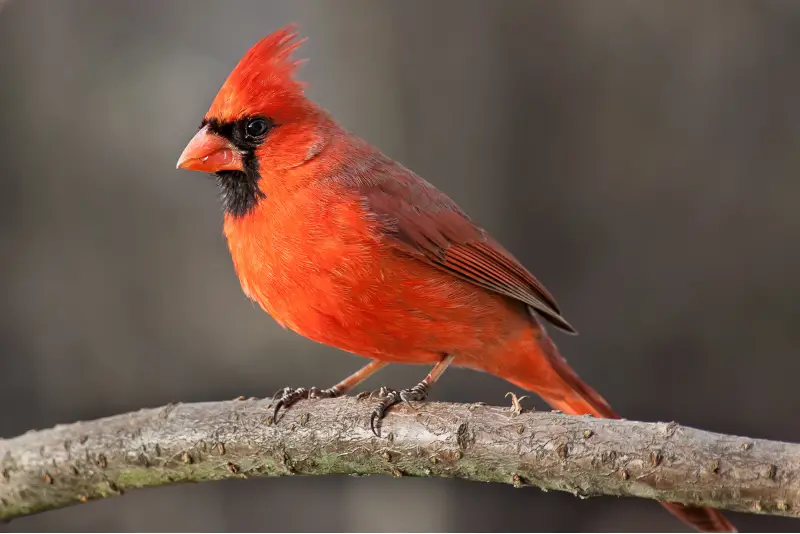
As the state bird of Illinois, the Northern Cardinal is the most well known red-colored bird not only in the state, but in all of North America.
Male Northern Cardinals have a bright crimson red coloration on their head, chest, and belly, and slightly darker red on their back and wing feathers.
In addition, the face has a black mask extending from the bright red bill to the throat.
This red bird is the state bird of Illinois
Female Northern Cardinals are not quite as colorful as males, and have a more buff-brown body color with some reddish tinges, although they also have a bright red bill.
The Northern Cardinal is a common bird in Illinois, and can be seen year round in gardens, small forests, and parks.
During the winter months it doesn’t defend its territory, and sometimes gathers in flocks of up to 25 individuals that feed together. This red-colored bird is a regular visitor at bird feeders.
Northern Cardinal song:
(Source: Paul Goltz, XC470302, www.xeno-canto.org/470302)
House Finch
Scientific name: Haemorhous mexicanus
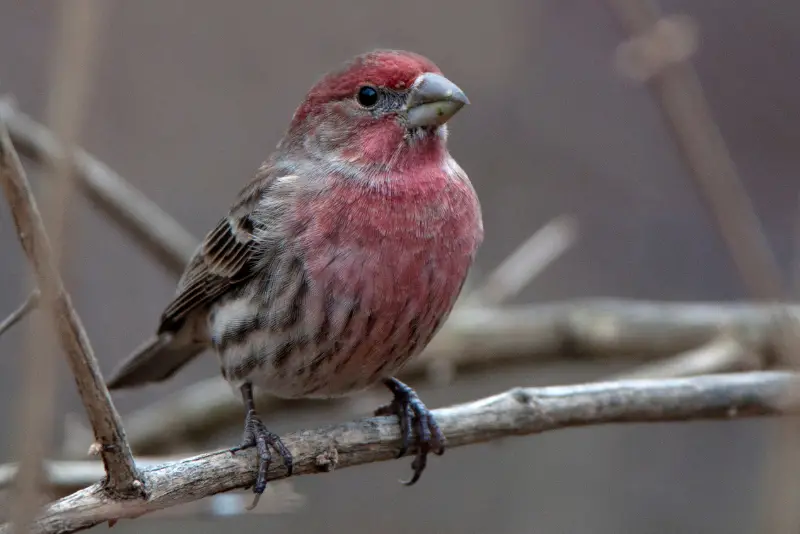
The House Finch is the most common red bird in North America, and is mostly found in settled areas, ranging from small towns to large metropolitan centers.
Adult male House Finches can be identified by the bright red feathers on the head and upper breast, although in some cases they are slightly more orange or yellowish in color.
The females lack any red coloration, and instead have grayish streaks on a brown background.
The House Finch was originally a western bird, and it wasn’t until the 1940s that this bird was discovered in New York and other places on the east coast of the US.
The eastern House Finch population began to grow in the 1950s and 60s, and by the year 2000, it had expanded so far west that it connected with the original western population.
The House Finch is entirely herbivorous, and feeds on seeds, buds, and fruits.
If you set up a bird feeder in your backyard, you can expect House Finches to be among the first birds to visit it.
The House Finch is found in Illinois all year round, and while it is not a migratory bird, it does move to areas with more food outside of the breeding season.
House Finch sound:
(Source: Thomas Magarian, XC531574, www.xeno-canto.org/531574)
Summer Tanager
Scientific name: Piranga rubra
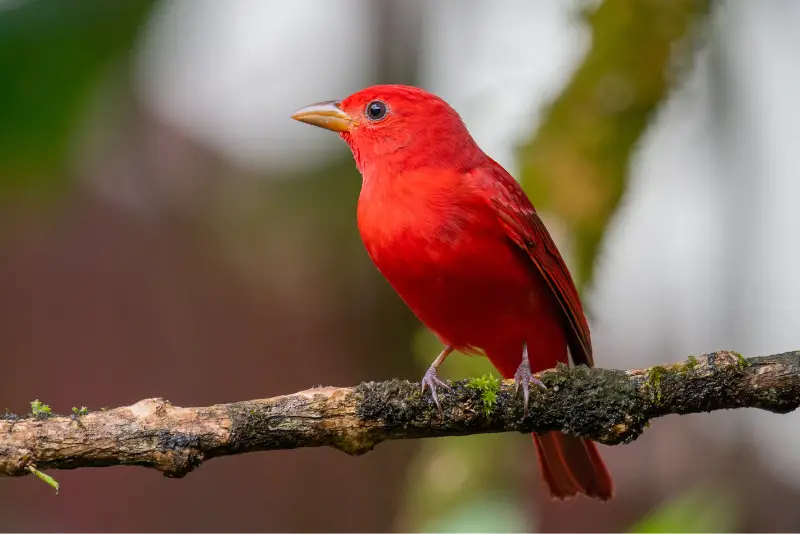
The Summer Tanager is a beautiful and alluring songbird with a peaked (as opposed to rounded) crown.
Adult male Summer Tanagers are entirely bright red, although they have slightly darker feathers on their wings.
It can be hard to observe Summer Tanagers, since they like to forage high in the treetops of deciduous and mixed forests.
In contrast to males, females and immature birds are buff yellow, although they sometimes have a few patches of pale red.
The Summer Tanager is a summer visitor and breeding species in Illinois, and can be seen here from May through August.
It is a strict migratory bird and spends the rest of its year in Mexico and Central America
Summer Tanager song:
(Source: Ron Overholtz, XC559000, www.xeno-canto.org/559000)
Scarlet Tanager
Scientific name: Piranga olivacea
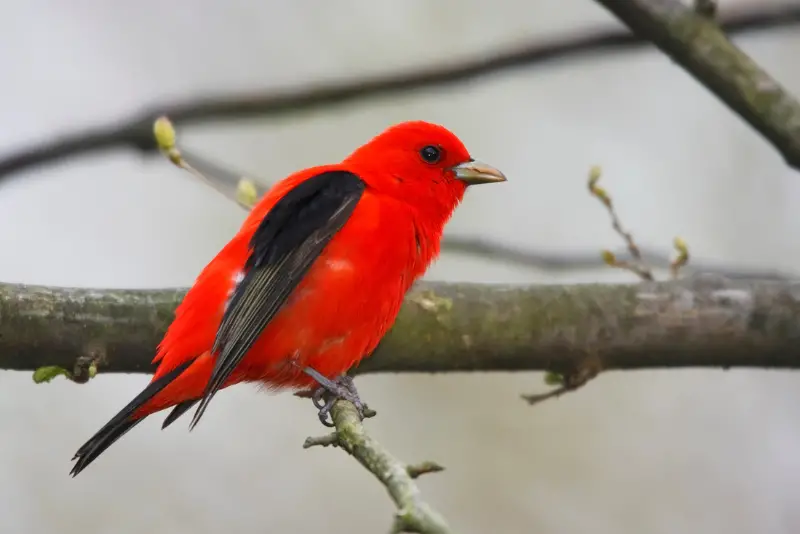
The Scarlet Tanager is a bird with a tropical appearance, due to the bright scarlet plumage of the males, which contrasts with their coal-black wings and tail feathers.
Both sexes sing a similar song in order to mark and defend their territory from other Tanagers.
But unlike the startling bright red color of the male, the female looks more like a pale yellow Illinois bird.
The Scarlet Tanager is a summer visitor to Illinois, and spends its winter in Central and South America.
This red bird loves warm temperatures, and thus arrives late in spring, and leaves early in fall. During spring and fall, Scarlet Tanagers from Canada can be seen passing through the state.
Both sexes sing a similar song in order to mark and defend their territory from other Tanagers.
While there are many Tanager species in the world, most of these are tropical, and the Scarlet Tanager is the only Tanager found in Illinois.
Scarlet Tanager song:
(Source: Christopher McPherson, XC691899, www.xeno-canto.org/691899)
Red-headed Woodpecker
Scientific name: Melanerpes erythrocephalus
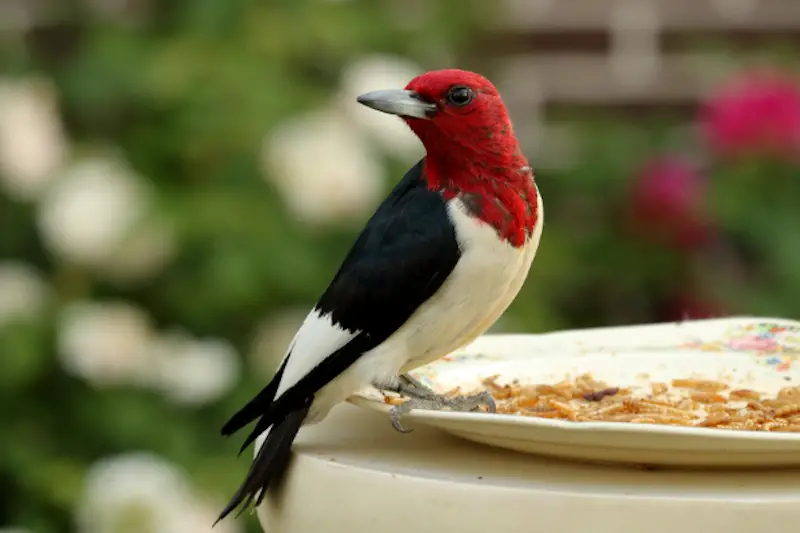
The Red-headed Woodpecker is one of the few non-dimorphic woodpeckers, which means that males and females look alike.
Red-headed Woodpeckers have an all-red head with a solid black back. They also have a white chest, rump and belly, as well as black wings and a black tail. The bill and legs are gray.
In Illinois, no other woodpecker has an all red head. Only the Pileated Woodpecker has a head that is mostly black and somewhat red.
The Red-headed Woodpecker favors wide-open forests or forests with plenty of dead or rotten limbs.
It may use the same nest cavity for multiple years in a succession, in contrast to other woodpeckers that only use them once or for a small period of time.
It used to be the most common woodpecker in Illinois, but the population has unfortunately declined by more than 90 percent, and the Red-headed Woodpecker is now a rare sight in Illinois.
Red-headed Woodpecker sound:
(Source: Matt Wistrand, XC698853, www.xeno-canto.org/698853)
Red-bellied Woodpecker
Scientific name: Melanerpes carolinus
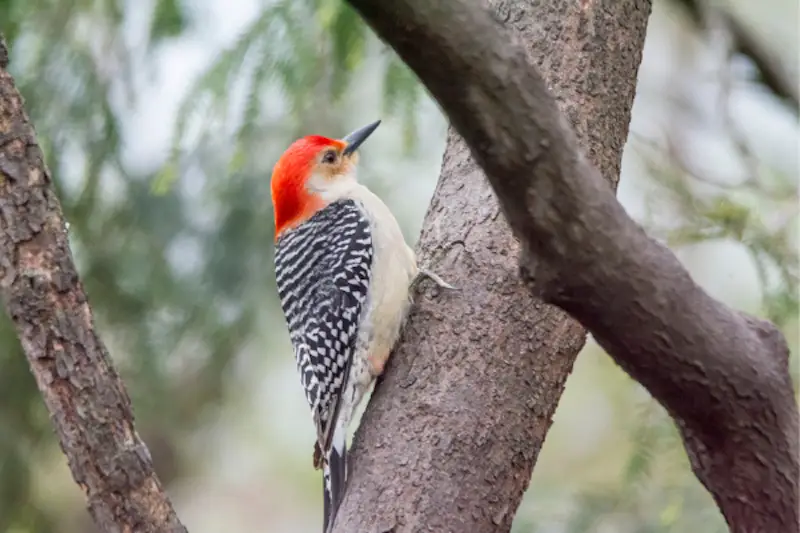
The Red-bellied Woodpecker has a black-and-white “Zebra” pattern on its back, as well as a white rump.
Its red crown goes all the way down to the base of the neck. Both sexes look similar, although the female has a partially gray crown.
The Red-bellied Woodpecker favors shady woodlands, forest edges and backyards with old trees.
It excavates holes in rotting wood to locate beetles, centipedes, spiders, and other creatures.
During winter, this bird stores berries and acorns in tree crevices and cracks. Every year, the Red-bellied Woodpecker excavates a new nest below the previous one in the same tree.
While it is named for the reddish tinge on its belly, this can be hard to see unless you get a close up view.
Fortunately, this beautiful red headed bird is steadily expanding its range across the whole country.
Red-bellied Woodpecker sound:
(Source: Bruce Lagerquist, XC713255, www.xeno-canto.org/713255)
Pileated Woodpecker
Scientific name: Dryocopus pileatus
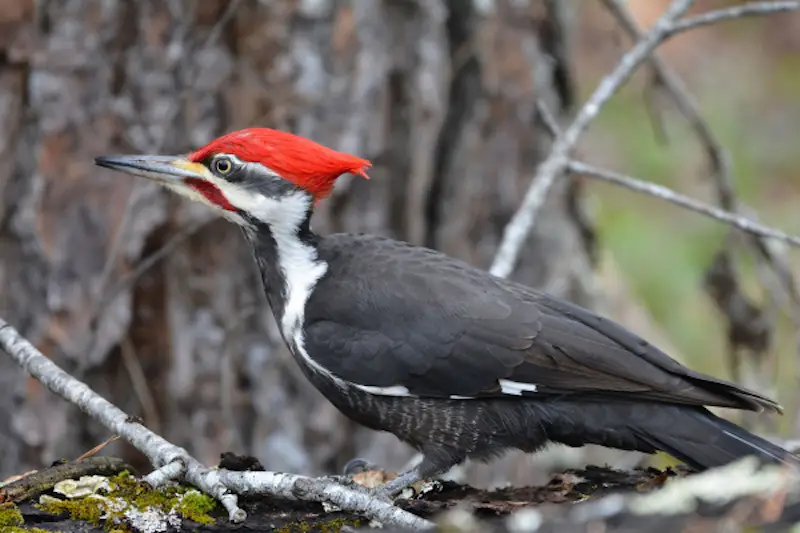
The Pileated Woodpecker is a large, crow sized woodpecker that has a bright red crest and forehead, as well as a red mustache in males.
The rest of the body is mostly black, although the white front edges of the wings flash brightly during flight.
The Pileated Woodpecker is the largest woodpecker in Illinois, and is a very shy bird that is mostly found in extensive tracts of woodland.
In order to find insects to eat, the Pileated Woodpecker drills oval holes in tree trunks that may be up to several feet long.
You can find large wood chips lying on the ground around its feeding trees, which is a tell-tale sign that Pileated Woodpeckers have been at work.
Carpenter ants are its favorite snack, and it feeds its nestlings regurgitated insects. The young woodpeckers leave the nest with pretty much the same appearance as adults.
Pileated Woodpecker sound:
(Source: Larry Joseph, XC634533, www.xeno-canto.org/634533)
Red Crossbill
Scientific name: Loxia curvirostra
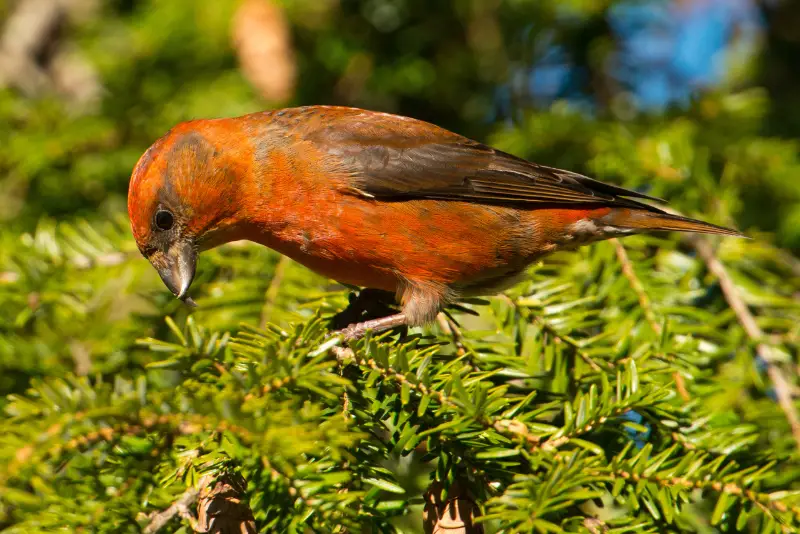
These birds get their name from their distinctive bills, which resemble a bent pair of scissors with their points crossed.
Male Red Crossbills have a deep red underside, head, and rump, while their wings and back are dark brown
Females and immature Red Crossbills are more inconspicuous, and are olive-colored with streaks on their flanks and belly.
Red crossbills are able to harvest seeds from pine cones by cutting through the scales of the cones with their crossbill.
They will use their feet to keep the cones pinned down while they use their tongues to pick the seeds out of the cones and then eat them.
The breeding season of Red Crossbills is timed to coincide with ripening of pine cones, and can sometimes start as early as February.
Red Crossbill song:
(Source: Anders Westman, XC735250, www.xeno-canto.org/735250)
Ruby-throated Hummingbird
Scientific name: Archilochus colubris
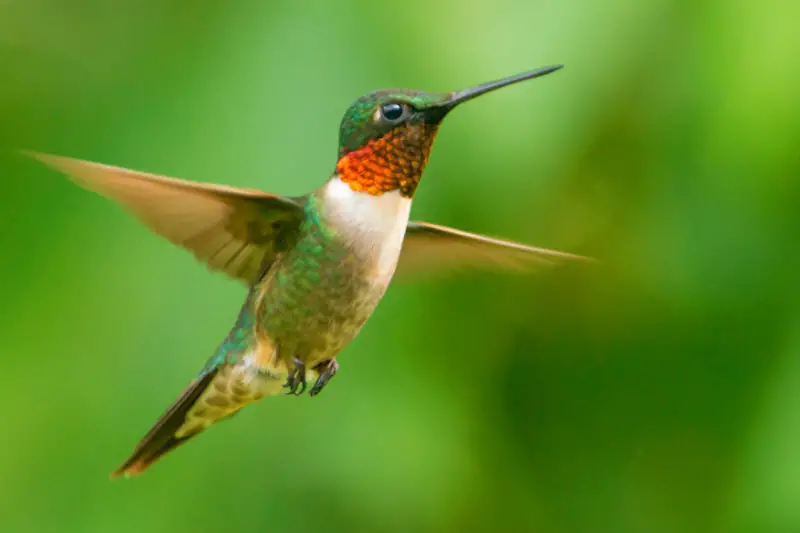
The Ruby-throated Hummingbird is the smallest bird in Illinois.
The male has a black throat that reflects flashes of ruby red when it catches the sunlight.
Similar to other Hummingbirds, this bird can fly straight up, down, or backwards, and can also hover in mid air, with its wings generating a humming sound like a tiny generator.
Hummingbirds are fascinating creatures that breathe up to 250 times per minute and have a heartbeat of over 1,200 times per minute.
The Ruby-throated Hummingbird is attracted to gardens and backyards that have tubular flowers that produce a lot of nectar.
In addition to flower nectar, it also feeds on insects. It is a long-distance migratory bird, and spends its winter in Central America.
Ruby-throated Hummingbird sound:
(Source: Christopher McPherson, XC691886, www.xeno-canto.org/691886)
Yellow-bellied Sapsucker
Scientific name: Sphyrapicus varius
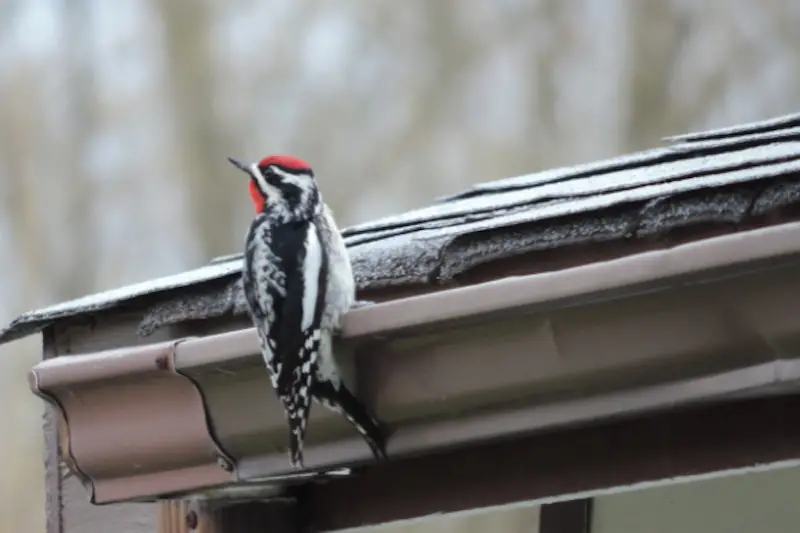
The Yellow-bellied Sapsucker is a winter visitor in Illinois that can be seen on migration in the northern part of Illinois, and wintering in the southern part.
The male has a checkered back with a scarlet red crown, forehead, and chin. It also has a yellowish tinge on its belly and chest. The female looks similar to the male, but has a white chin.
The Yellow-bellied Sapsucker is found in small forests, as well as rural and suburban areas.
It drills holes into trees in order to drink the sap that oozes out, which it. The bleeding sap also attracts insects, which the Yellow-bellied Sapsucker feeds on.
Yellow-bellied Sapsucker sound:
(Source: Jim Berry, XC562030, www.xeno-canto.org/562030)
Purple Finch
Scientific name: Haemorhous purpureus

The Purple Finch is a little songbird with a compact body, a conical beak, and a head that is disproportionately larger than its body.
The heads and breasts of adult males are a deep shade of raspberry red, while the backs of their bodies are streaked with red and brown. The flanks are cream colored with pink streaks.
Birds from the eastern part of the range have a white belly, whereas birds from the western part of the range have a gray belly. Purple Finches in Illinois have a gray belly.
The upperparts of females and immature birds are streaked with a grayish brown, while the underparts are a light cream color with brown streaks.
During the months of May through August, the Purple Finch is found breeding in the northern part of its range in Canada and the northern USA.
During the winter, however, these birds migrate south and spend the cold months in the eastern United States. In Illinois, they show up as rare winter visitors.
Purple Finch song:
(Source: Thomas Magarian, XC534247, www.xeno-canto.org/534247)
White-winged Crossbill (Two-barred Crossbill)
Scientific name: Loxia leucoptera
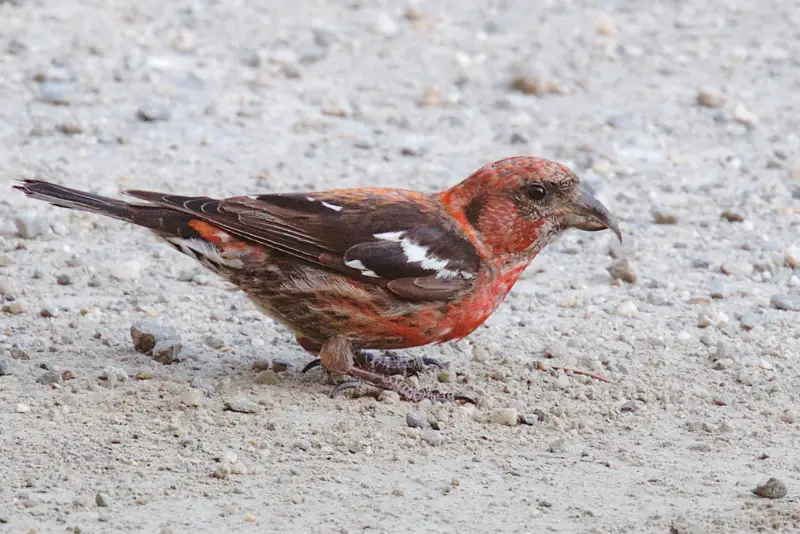
Similar to the Red Crossbill, the White-winged Crossbill has a cross-tipped beak.
Most of the body plumage of adult male White-winged Crossbills is pinkish red, although it is paler compared to the color of Red Crossbill males.
The tail and the wings are black, with two prominent white wing bars visible on the latter (explaining the name of this bird).
The body of females is streaked with a yellowish color, but their wings are black with a wingbar pattern similar to that of males.
White-winged Crossbills are largely non-migratory, and remain in the breeding range in Canada and the northern United States all year round.
In Illinois, White-winged Crossbills are seen as scarce winter vagrants that are more abundant in some years.
White-winged Crossbill song:
(Source: Christopher McPherson, XC6026667, www.xeno-canto.org/602666)
Rose-breasted Grosbeak
Scientific name: Pheucticus ludovicianus
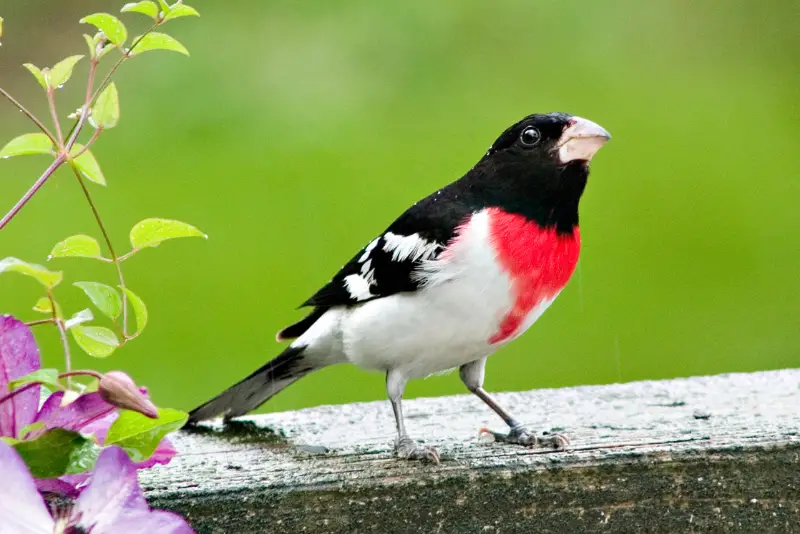
The Rose-breasted Grosbeak is easily identifiable due to its distinct markings and its large beak.
During the summer, adult males have a scarlet red chest, which contrasts with their jet black hood and back. Their black wings have white patches and white wing bars.
Adult females and immature birds, on the other hand, have streaked brown plumage that is lighter on the underside than on the back.
They also have a white eyebrow stripe and white wingbar.
The Rose-breasted Grosbeak breeds in the forested parts of northern Illinois from May through August. It is a migratory bird, and migrates to Central America to spend the winter months.
Similar to other Crossbill species, it specializes in feeding on the seeds of pine cones.
Rose-breasted Grosbeak song:
(Source: Ray Cooke, XC694260, www.xeno-canto.org/694260)
What are the most common red birds in Illinois?
The most common red birds found in Illinois are Northern Cardinals, which can be seen in most backyards, gardens, and parks, and thrive close to humans.
The second most common red-colored birds found in the state are House Finches, which are common breeding birds and year round residents in deciduous, coniferous, and mixed woodland.
What red headed birds can you see in Illinois?
There are five types of red headed birds in Illinois:
- House Finch
- Red-headed Woodpecker
- Scarlet Tanager
- Red-bellied Woodpecker
- Pileated Woodpecker
The most common red headed bird in Illinois is the House Finch. But keep in mind that only males have a red head, while females are gray brown all over.
The most stunning red headed bird in Illinois is the Red-headed Woodpecker, but unfortunately these birds have become quite rare over the past decades.
What birds are black and red in Illinois?
There are three types of birds in Illinois that are black and red:
- Summer Tanager
- Red-winged Blackbird
- Northern Cardinal
Red-winged Blackbirds are the most common red and black birds in Illinois. Males are almost entirely black, but have a patch of bright red on their shoulders.
Male Northern Cardinals are almost entirely red-colored birds, except for their black face.
What small birds in Illinois are red?
If you see a small bird in the state of Illinois that is red, you’re most likely looking at a House Finch, which is common statewide. Males can be readily identified by their reddish head, upper chest, and back
However, during winter you can also encounter two other small red birds in the state: the Purple Finch and the Common Redpoll. Both of these are scarce winter visitors in Illinois.
How to attract these Illinois birds to your yard
The top 5 things you can do to attract red birds to your yard are as follows:
- Set up a feeder with sunflower seeds or a seed mix
- Set up a bird bath
- Plant shrubs to provide nesting opportunities
- Plant native fruiting plants
- In order to attract fruit-eating birds, offer apples or berries at your feeder
Final remarks
This concludes our article on the types of red songbirds found in Illinois.
If you’ve spotted one of these red birds while bird watching in your backyard, hopefully this ID guide will help you identify it quickly and easily.
And if you enjoyed this article, check out our guide to the large birds of Illinois.
